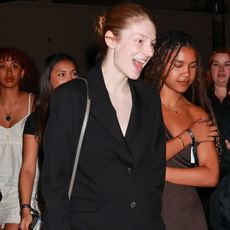Actress Wunmi Mosaku Knows Good Prints and Told Us Where to Source the Best Ones
"I’m definitely a fabric girl.”
Google Wunmi Mosaku red carpet and you’ll be treated to a myriad of looks featuring eye-catching patterns that zig, zag, and swirl in a range of beautiful jewel tones and vibrant hues. The Nigerian-born, UK-raised actress doesn’t shy away from the bold and bright. It’s one of the many reasons we admire her and a trait that is mirrored in her on-screen work as well.
While you might not be familiar with Mosaku yet, trust that that won’t be the case for long. Having already carved out a meaningful acting career in Britain—it’s worth mentioning in 2017 she became only the second Black woman in the BAFTA 62-year history to win an award, that for her performance in Damilola, Our Loved Boy— Mosaku is breaking into the U.S. in a big way this fall with two performances so powerful you’ll have to pick up your jaw from the floor when you are finished watching. The first is in HBO’s topical sci-fi/horror/fantasy thriller Lovecraft Country in which Mosaku plays jazz singer Ruby Baptiste who struggles to rebuild a relationship with her flaky sister Leti (Jurnee Smolett) and finds herself exploring racial identity in an episode so unimaginable the Hollywood Reporter said it will likely "spawn a year of think pieces.” And later this month, she finds herself at the center of another thought-provoking horror story, His House. In the Netflix film, Mosaku shines as Rial, a Sudan refugee grieving the life she was forced to leave behind only to be haunted by the choices she and her husband made along the way.
After watching both performances, I jumped on the phone with Mosaku to talk about that insane Lovecraft episode, finding more compassion for others, and yes, where she sources those incredible fabrics!
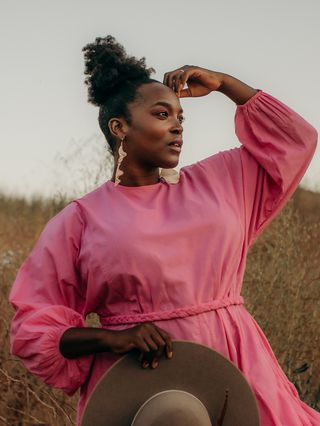
Let’s start with Lovecraft Country, because it’s a fantastic watch! You have an incredible cast and the likes of Misha Green and Jordan Peele behind the scenes. It seems like a dream job scenario for any actor.
Absolutely. I was totally stunned and in shock when I got offered the job. Even when I got the recall, I was like oh, wow! Truly, you always do your best in an audition. Even if it’s terrible, you’ve done your best in the moment. So I came out and was like I did my best, but I wasn’t like man, I smashed it. When I got offered the job I think I was on the last two pages of the book, and I just really loved the book and I really loved the pilot. I had never seen, read, heard of anything quite like it. I’m not massively into horror and sci-fi, but there’s one book called Flowers for Algernon, which is set in the past but has a sci-fi element that I just loved and [Lovecraft Country] has the same things, being set in the past but having this futuristic quality. I just loved it and I was so excited to work with everyone involved.
Then I had my audition with Jurnee, and we really grew in that audition. You come in, you know, you’re nervous, she has the job, I’m testing for it, it’s my final round, I just signed the contract, and I’m meeting everyone properly for the first time, and you come in, and sometimes it can be quite polite. The thing about Ruby and Leti, though, is there is no politeness between them, they are just honest, they are sisters, they hate each other, they love each other, they find each other hilarious, they find each other infuriating, and by the end of that audition process me and Jurnee were having this huge, like, row. We had gotten into this heated exchange and it was just exhilarating. The whole process was exhilarating. There is so much passion and so much fire in [this show], it feels like a pressure pot.
I was drawn to your character Ruby Baptiste right away. She has such an unapologetic spirit about her. I know when first auditioning for these projects you sometimes get very little information on your character. Do you remember what stood out to you about Ruby from the details you did have?
For the first round, all I had was the pilot and it was just the relationship between Ruby and her sister Leti. I have two older sisters and I’m the baby who refuses to be babied and to be bossy, so that kind of dynamic between siblings and sibling rivalry, it’s so normal for anyone with a sibling. It was so complicated and I was like who are these two [women]? The first scene with her and Leti it’s like, oh they have a deep history with each other. You know that they are not in sympatico, that they spend time apart, that they have different responsibilities, and that’s just in literally one scene. And then getting told what happens to Ruby throughout the show, I was like She does what now?! And how are we going to do that? I was so intrigued by it, because it feels like a betrayal. To try and get my head around why she does what she does, how she fits in, how she takes to the race thing, it feels like a betrayal of all things Black and beautiful and wonderful. But you know, it was the 1950s, so I get it.

I love the music scenes with Ruby. Were you nervous at all to sing for this part?
Oh yeah, absolutely terrified! I loved it, though. That was probably my favorite time away from set, was doing my singing lessons and the guitar lessons, because I felt bolder in my voice in a way that I hadn’t before. I would always say I can sing, but I’m musical. I’m very good at following instructions, reading the music, and singing as it’s written down, but there was the challenge when I had to improvise. My strict singing instructor and coach would push me to really explore around the beat, around the notes, around everything, and so by the end it came a little more naturally.
Episode five is a big one for Ruby. I don’t want to give too much away, but I did find it interesting, and at times difficult, to see what Ruby would do as Ms. Davenport.
It was really painful, because you have to explore your own rage and your own anger, and that’s something I don’t do regularly. I don’t look at the negative. I’m the kind of person who never raises conversation about race and stuff and how it affects my life as soon as I walk out the door. I’ve never really spoken about it honestly and to anyone really outside of my husband. It started for me more with Ruby, because the feeling you have to draw upon to do what she does, there was pure rage there and I hadn’t tapped into that. I had to ask really difficult questions and face up to how I have been treated, how I am received, how I have manipulated myself to fit in and assimilate and not be angry, so it was difficult, because Ruby really goes all the way to a place I have never ever imagined and finding that rage. I even know for Jaime Neumann, that particular scene, just the emotion in the room and in ourselves was huge. We were both shaking with fear of the rage. It was intense.
I can’t not mention the show’s costumes, because across the board they are beautiful. Do you have a favorite Ruby look?
I watched episode four the other day and I really loved the outfit she wears when she goes to hand in her CV, it’s an original 1950s dress. I just think it was so well made and the fabric was beautiful. It was such a simple design, but I think made quite an impression. I like the green dress in episode three when they come to the Winthrop House. Our costume department was amazing. Dayna [Pink] and Terry are just true artists and I really feel like they did such an incredible job on the whole show. Oh my blue dress from episode one! I certainly loved that. I wish I could have taken everything home.
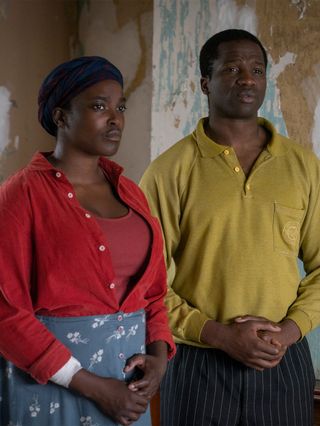
Your next project, the film His House, similarly meshes horror film tropes with the horrors of the real world. It’s definitely scary, but it also really makes you think. What do you hope people take away from watching the film?
I hope that people have a deeper understanding of others who are in difficult circumstances and difficult environments when they have to leave their homes. I don’t think anyone ever truly wants to leave their home. I just don’t. But people are forced to because things aren’t safe, and I hope that people really understand that people don’t make those decisions and those dangerous, treacherous journeys lightly and that understanding and empathy are a kinship.
Before His House, I felt like I cared and understood and was like, "Let’s get rid of borders." I’ve always been that kind of person, but reading it and seeing the haunting of people materialized and internalized, it’s so painful. [Rial and Bold] have to face everything they’ve been through and everything they have lost and left [behind], and everything they’ve become because of it. Their marriage has changed, they themselves have changed, they have to accept the new people they are and they also have to accept the haunting, of both the house and their past.
I just really hope that people care more. That’s how I feel about this whole period of time—we need to care more. We are responsible for us as individuals, we’re responsible for our role in this pandemic, and we’re responsible for other people. We are not an island—we are entwined and we rely on each other, and it’s not just for racists to change, it’s for all of us to change and invoke change.
You are an ActionAid ambassador. Can you tell me a little about what Action Aid is and how you are working with it?
ActionAid is a charity that works with women and girls trying to fight for more equality and justice. What I love about ActionAid is they work with already established communities, so it’s not really like they come in telling people how to live their lives—they work within the community. A big thing we were working on last year was a women’s shelter in the north of Ghana. If someone was experiencing violence in the home, they could go to this shelter with their children. They also encourage people to go to the police, so there is accountability and repercussions and education. There are women’s groups where women come to talk about problems in the home and then the men have a group so that they can educate them on how to be better partners. They are an amazing charity.
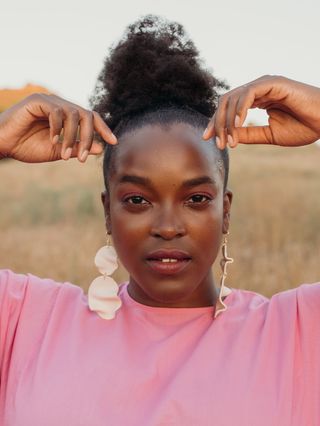
Pivoting to fashion, I was stalking your Instagram and saw that you designed a suit you wore to the Toronto Film Festival last year. Do you design a lot of your own clothes?
I do. I usually start with a fabric. The fabric gives me an idea of what I want to wear. I actually sewed my own wedding dress and I sewed my flower girl dresses. I found some fabric I just loved and it took my wedding dress in a direction I didn’t think I was going to go in, but I did in the end because of the fabric. So that’s me, I’m definitely a fabric girl. For that event I was like I think I want to wear a suit. I always go for skirts and dresses for the most part, and I realized sometime last year that I don’t always feel my best in it. I think the thing I feel most comfortable in and the most sexy in is a headwrap and a t-shirt and jeans or a sweatshirt and jeans. And I thought well let me try a suit then, let me try something different. I got some inspiration and the fabric kind of guided me to that design. I didn’t actually sew that one, though, because suits take a lot of talent.
So beautiful bold prints are a Wunmi signature on and off the red carpet.
Absolutely! I just really love prints and color. It feels like me. It’s what I’ve grown up in living in a Nigerian household and being with my mom and grandma. Also, Nigerians match. We call it aso ebi, which is one fabric that the whole family will wear in a different style. I’m just so used to being given a piece of fabric and making something. Or choosing a piece of fabric for my family and seeing what they make out of it.
Inquiring minds want to know, where do you source a lot of your fabrics?
I go to Kutula in LA. They have the scoop on finding old-school prints and patterns. Vintage patterns I remember seeing as a child and haven't seen in decades, I've seen in their shop. I generally go to Brixton Market and Peckham in London, and then Liverpool Street, but these are generally Dutch wax prints. Busayo NYC is a Nigerian designer and fabric maker and the fabric store in Ghana is Djoletex Industries in Osu, Accra. Both [stores] use traditional methods of printing and dyeing handmade fabrics with unique designs. It’s all a part of my heritage and I love it, but I do want to know more about the traditional ways of making the fabrics, like asoebi from Nigeria and kente from Ghana. I have a lot of those around the house. They are the more ceremonial fabrics, which are amazing.
Photographer: Ashley Randall
Up Next: The Boys actress Erin Moriarty on season two and owning her NYC-L.A. hybrid style.
Jessica Baker is Who What Wear’s Executive Director, Entertainment, where she ideates, books, writes, and edits celebrity and entertainment features.
-
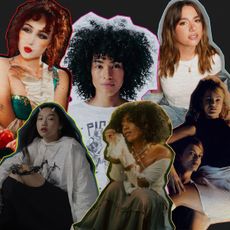 Our 2024 "Ones to Watch in Music" List Is Here!
Our 2024 "Ones to Watch in Music" List Is Here!Time to refresh your playlists.
By Jessica Baker
-
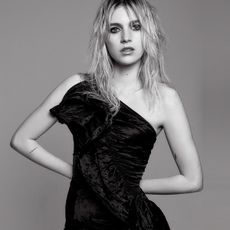 Nell Tiger Free Is This Generation's Scream Queen
Nell Tiger Free Is This Generation's Scream QueenFrom Servant to The First Omen, the actor has found her sweet spot in the horror genre.
By Jessica Baker
-
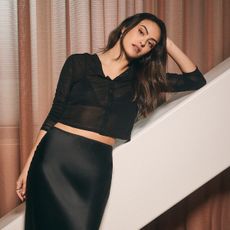 Camila Mendes Is Getting Back to Her Roots
Camila Mendes Is Getting Back to Her RootsStarting with her new film, Música.
By Jessica Baker
-
 The Transformation of Sydney Sweeney
The Transformation of Sydney SweeneyYou've never seen the 26-year-old quite like this.
By Eliza Huber
-
 Celeste O'Connor Wants to Play Dress-Up All the Time
Celeste O'Connor Wants to Play Dress-Up All the TimeThe Ghostbusters: Frozen Empire actor knows how to serve a carpet look.
By Jessica Baker
-
 Mckenna Grace Channels Old Hollywood Glamour for Ghostbusters Premiere
Mckenna Grace Channels Old Hollywood Glamour for Ghostbusters PremiereGo behind the scenes of her crimson look.
By Jessica Baker
-
 Kristen Stewart Is Calling the Shots
Kristen Stewart Is Calling the ShotsThe Love Lies Bleeding star joins fellow actor-turned-director Riley Keough in conversation.
By Jessica Baker
-
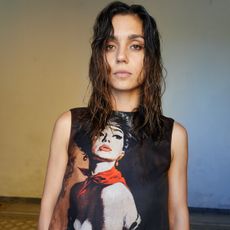 This IWD, Cristiana Dell'Anna Brings the Story of Cabrini to the Forefront
This IWD, Cristiana Dell'Anna Brings the Story of Cabrini to the ForefrontBy Jessica Baker
